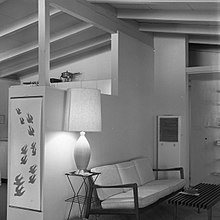 Tract house in Tujunga, California, featuring open-beamed ceilings, c. 1960 | |
| Years active | 1945–1970 |
|---|---|
| Location | All the world. Mainly in North America, Brazil and Europe[1] |
| Influences | International, Bauhaus |
Mid-century modern (MCM) is a movement in interior design, product design, graphic design, architecture and urban development that was present in all the world, but more popular in North America, Brazil and Europe from roughly 1945 to 1970 during the United States's post-World War II period.[2]
MCM-style decor and architecture have seen a major resurgence that began in the late 1990s and continues today.[3]
The term was used as early as the mid-1950s, and was defined as a design movement by Cara Greenberg in her 1984 book Mid-Century Modern: Furniture of the 1950s. It is now recognized by scholars and museums worldwide as a significant design movement.
The MCM design aesthetic is modern in style and construction, aligned with the Modernist movement of the period. It is typically characterized by clean, simple lines and honest use of materials, and generally does not include decorative embellishments.
On the exterior, a MCM home is normally very wide, partial brick or glass walls, low footprints with floor to ceiling windows and flat rooflines, while exposed ceilings and beams, open floor plans, ergonomically designed furniture and short staircases connecting rooms throughout the house often defines the home's interior.
- ^ Mid-Century Modern in the USA, Brazil and Europe
- ^ "Understanding Mid-Century Modern and How To Use it in Your Home". September 29, 2017.
- ^ "Mid-century modern is the style that won't die". The Washington Post. June 13, 2023.